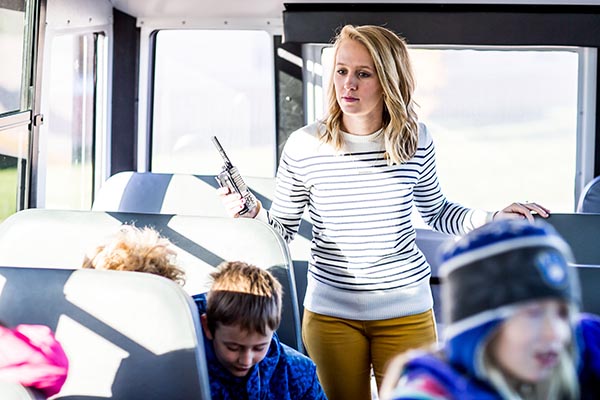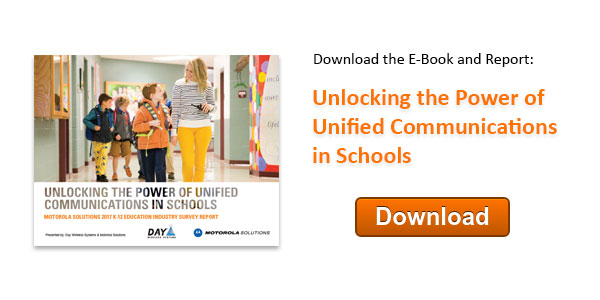For parents, there’s nothing more important in their lives than their children. They are our living legacies, and as such, they deserve to walk into a safe and functional school environment every day. And while many among us are divided on how to facilitate that type of environment, most will agree that a strong, well-integrated emergency communications plan should be part of the equation.
During a crisis, lives can be saved when seconds are saved. Better, faster decisions are made with instant access to information and improved situational awareness. Schools that are able to instantly connect staff to first responders in an emergency are safer. Districts that are able to monitor buses, students, assets and staff are better equipped to make sound decisions. And administrators who can notify the right personnel of an emergency with a push of a button are more prepared.
In a new report, “Unlocking the Power of Unified Communications in Schools,” Motorola Solutions surveyed more than 720 school personnel in 48 states, sampling from school districts that range in size from 500 students to more than 10,000. The report found that two-way radio usage in schools has tripled since 2015 despite increasing rates of smartphone proliferation. In fact, more schools (30 percent) use two-way radio than cellphones (17 percent) as the preferred communication channels for:
- Coordinating with staff on school campuses (teachers, administration, transportation, security, maintenance)
- Communicating between schools
- Contacting school-bus drivers
- Talking with emergency first responders in real time
Clearly, two-way radio and cellular communications each have their advantages and disadvantages, hence the close usage percentages between them. However, as Motorola’s new report concludes, there isn’t any reason why educational staff can’t have the best of both mediums on a single platform to enhance student safety. Let’s look at how digital two-way radio and cellular communication can be brought together for a truly unified communications system in our schools.
Safer schools start with better communication systems
There has traditionally been a divide between two-way radio based communication and cellular communication for the simple reason that they are entirely different communication technologies. Consequently, some school districts may opt for one or the other, or, alternatively, mix and match among different departments. The result is decentralized communication infrastructure that lacks the speed and efficiency necessary to keep students and staff safe during an emergency.
Motorola’s survey revealed that “communicating with school personnel, on any device, anywhere,” was seen as a safety and communication priority for 65 percent of schools. However, only 15 percent of those institutions reported that they did in fact have that capability. This shortfall stems at least partly from the inability to bring two-way radio and cellular communication together under a single, unified communications umbrella.
And both technologies certainly have their merits. Two-way radio users will cite benefits such as:
- Reliability and uptime
- Better battery life (12-28 hours)
- Licensed, dedicated frequency bandwidth (you’re not sharing a high-traffic cellular tower).
- Secure transmissions
- Optimized campus or district coverage
- Instant communication via push-to-talk
Cellular users will argue for advantages such as:
- Device preferences
- Group text messaging
- Ability to dial 911
- Ability to communicate across other digital platforms (desktops, laptops, etc.)
- Off-campus communication
The question, then, is how to get radio’s availability and instant push-to-talk functions with cellular’s extended range, messaging, and wide range of devices? Many schools have struggled to solve this problem. Case in point: 30 percent of respondents are using analog-only two-way radio, which hampers any hope of digital integration.
The alternative – relying exclusively on landlines, internet connection or cellphones – means less reliable campus-wide signal, limited redundancy and no push-to-talk functionality. This is unacceptable, given how important is to be able to quickly communicate to the right teams during a school crisis.
In other words, a non-unified communication system is inadequate to provide school districts with the accessible, available, reliable, universal communication system they need to optimize staff coordination and student safety.
Unify communication with WAVE for real-time, district-wide coordination
When two-way radio and cellular are used together, the result is a truly unified team communication system that enables fast, efficient and reliable communications when it’s needed most. This is made possible through several key technologies offered by Motorola Solutions:
- WAVE: This application extends push-to-talk functionality to smartphones, laptops, tablets and PCs. Two-way radio users can talk with cellular users, and vice versa, with the push of a button. This is especially useful for administrators, who need to be able to communicate with one another anywhere in the district during a crisis. It also means that in the event of an emergency, any device with the WAVE app installed can receive a clear audio message.
- MOTOTRBO radio systems: MOTOTRBO systems are a combination of infrastructure, radio subscribers (handhelds and mobiles) and applications to provide a complete and reliable digital communications platform.
That’s not all. Direct, real-time communication with first responders from the moment they’re requested to the moment they enter a school building is made possible by a partnership between Motorola Solutions and SchoolSAFE. This functionality is seen as a top priority for 76 percent of schools, but only 17 percent of schools currently possess it; however, that percentage will likely increase in the very near future thanks to Motorola Solutions and SchoolSAFE’s collaboration.
Again, nothing is more important than the safety and well-being of our students and the staff that enable them to grow and learn each day. To learn more about how Day Wireless Systems and Motorola Solutions can facilitate better staff coordination and student safety in our K-12 schools, download the full report, “Unlocking the Power of Unified Communications in Schools,” below.
EXTRACT
School districts need an accessible, available, reliable and universal communication system for optimal staff coordination and student safety.

